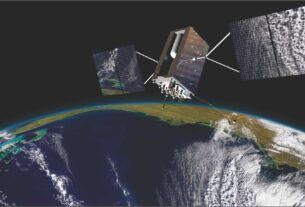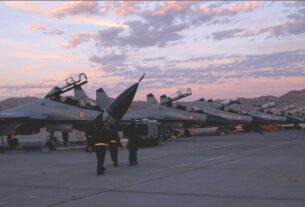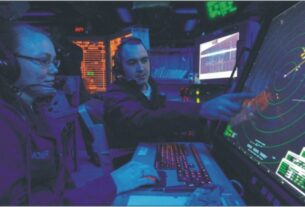Military strategists are unanimous in their view that network centric battlefield philosophy is the future of the warfare. For the defence forces in the thick of the battlefield, Network Centric Warfare (NCW), is a game changer and a force multiplier. In recent years, a range of satellites meant for a variety of end uses have become a critical element of the holistic and integrated NCW strategy. Synchronization and coordination between all combat formations through the efficient utilization of satellite resources is vital for successful NCW operations.
Meanwhile, the possibility of harnessing the potentials of cost efficient and easy to replace nano satellites, is being explored to support NCW. A number of countries including India have an ongoing programme to develop and launch nano satellites designed for a variety of applications. Normally, nano satellites are launched as piggy back payloads by a launch vehicle carrying bigger satellite payloads. Because they operate from the low earth orbit, the nano satellites have a lifespan shorter than the conventional space platforms. Even so, efforts are on the way to render nano satellites functionally efficient for operational uses on a regular basis.
Nano satellites
Despite their limited capability on account of their light weight, the nano satellites can be routinely used for applications such as communications and remote sensing. On its part, Indian Space Research Organisation(ISRO )is supporting universities and seats of higher learning including Indian Institute of Technology(IIT) to develop and build a range of nano satellites designed for applications such as communications, pollution monitoring and earth observation. These satellites are launched as piggyback payloads on-board the flights of the four stage Polar Satellite Launch Vehicle (PSLV) carrying larger, conventional satellite payloads.
It is for not for nothing that military strategists envisage a vastly improved role for nano satellites in support of NCW. For instance, in future, nano satellites could be deployed in aid of defence forces operating in remote, difficult to access areas for voice, data and even visual communications. As it is, US army researchers have already engineered what is called as SMDC-ONE nano satellite. This satellite is designed to serve as a communications outpost in space which the army units can easily access. However, as of now, SMDC-ONE is a technology demonstrator mission to establish the feasibility of using nano satellites for remote area communications under operational conditions. Similarly, nano satellites meant for earth imaging would help the defence forces with intelligence or threat in and around the areas of their operation.But all said and done, nano satellites can supplement and complement the capabilities of conventional, full fledged satellites.
Satellite bandwidths provide a secure mode of communications for helping army units in the field to accomplish tactical operations. Rightly and appropriately, NCW has been considered a vital element of the strategy meant for bringing about military transformation in all its manifestations. Computing power and a networked communications strategy supported by a range of satellites provide a shared awareness of the battlefield space. Studies carried out over the last two decades go to show that networking enables defence forces to undertake a complex range of missions in comparison to non-networked forces by improving the efficiency and effectiveness of the operations.
Clearly and apparently, NCW involves collaboration as well as sharing and swapping of information on a real time basis. Interoperability is the vital pillar of the NCW strategy. NCW relies on the imaginative exploitation of communications devices including satellites, smooth data flow and software power to enable networking of people, sensors as well as manned and unmanned platforms.
Satellites hold the key for enabling mobile communication in remote areas as well as for providing imagery, navigation, weather forecasting and missile launch warning all of which could give a strategic edge to NCW. Significantly, the network centric warfare strategy of US defence forces derive advantage from a large number of advanced, high power satellites meant for communications, navigation, weather forecasting, remote sensing, intelligence, surveillance and reconnaissance.
Clearly and apparently, navigation satellites have today emerged as vital space platforms with immense potentials to support the network centric operations of all the three wings of the services. A large, independent navigation capability that can be accessed anytime from anywhere holds the key to the success of network centric operations. The US led allied forces during their operations in both Afghanistan and Iraq relied heavily on satellite based navigation capability with hand held GPS portable devices to meet their strategic goals speedily and efficiently. Prior to that, the stunning effectiveness of the American GPS constellation was demonstrated during the “Desert Storm” operations of 1990-91 that was aimed at freeing Kuwait from the clutches of invading forces from the neighbouring Iraq.
As it is, network centric capability has now become an inseparable and indispensable part of the operational philosophy of defence forces around the world. Indeed net centric warfare architecture has evolved as a critical part of the “winning edge” warfare strategy. A successful network centric battlefield strategy hinges on the optimal utilisation of a string of satellites serving as “eyes” and “ears” in outer space. The full potentials of network warfare strategy can be realised only through the use of the satellite resources. But then as things stand now, Indian defence forces have only limited access to the INSAT/GSAT constellation of communications satellite and IRS series of earth observation satellites being operated by ISRO. Of course, there is a well conceived plan to equip all the three wings of the services with a string of satellites meant for a variety of end uses. Only a dedicated constellation of satellites would give Indian defence forces a veritable head start in refining network centric warfare capability.
Navigation capability
Luckily, for the lndian defence forces, which had suffered a massive intelligence failure before and during 1999 Kargil war with Pakistan, India’s own regional satellite navigation system, IRNSS-1, with four of the seven satellites already in orbit, could provide GPS services on an uninterrupted basis. With the launch of the three more satellites before the middle of 2016, IRNSS-1 constellation will become fully operational. The strategic advantage of operating an indigenous GPS system hardly needs to be emphasized especially during the critical times. The coverage area of IRNSS includes the Indian sub-continent and around 1500-km beyond the Indian geographical area. The IRNSS constellation has been designed to provide highly accurate position, velocity and time information services in real time and under all weather conditions.
For the Indian defence forces, the IRNSS- constellation will be an invaluable tactical tool in terms of launching high precision weapons including long range missiles with a high degree of accuracy. Dedicated navigation satellites have become indispensable for the aircraft, warships and ground forces to get a head start in the battlefield and derive tremendous tactical advantages to take the adversary by surprise. On a more practical plane, GPS satellites allow the soldiers to find objects and identify targets even under the cover of darkness, inclement weather or in unfamiliar territory.
Indeed, as strategic analysts point out, proper navigation in an unfamiliar territory that is devoid of easily identifiable land marks, is fundamentally vital for the successful accomplishment of reconnaissance missions and well planned military operations. Indian defence establishment has learnt through the hard way that the inputs provided by the GPS devices could be exploited to coordinate the movement of troops and supply with a high degree of efficiency. The GPS in tandem with GIS (Geographic Information System) allows military planners to pictorially view, plan, interpret and visualize data in ways that reveal solution and intelligence as never before. What is more, today GPS satellites have become an integral part of the Command, Control, Communications, Intelligence, Surveillance and Reconnaissance or C4ISR structure which is a key component of the network centric warfare.
Warfare strategists are fully well aware that satellites hold the key for a well co-ordinated and synchronised operations of a battlefield strategy by seamlessly integrating weapons systems, missiles, radars and sensor suits, UAVs, weaponised drones electronics and communications network, fighter jets, transport aircraft, logistics and support systems and defence forces spread across and around the world for sustaining strategic superiority at all levels of strategic operations.
In a development of significance, the Indian Navy the youngest of the three services, has already under its command a dedicated communications spacecraft that would drive its quest to position itself as blue water maritime force by boosting its network centric capability. The GSAT-7 advanced multi band communications designed, developed and built by the Indian Space Research Organisation( ISRO) was launched by means of an Ariane-5 vehicle of the European space transportation company Arianespace as a dedicated Indian naval space platform in August 2013.
The high performance GSAT-7 satellite which happens to be India’s first exclusive defence satellite has provided the Indian Navy a safe and secure communications capability to systematically network all of its offshore and onshore resources. With its 2000-miles nautical footprint over the Indian Ocean,GSAT-7 serves as force multiplier for the Indian Navy to network all its warships, submarines, aircraft and UAVs along with its ground based asset.
GSAT-7 would also provide the Indian Navy the necessary level of capability for its smooth and seamless integration into the tri service aerospace command the formation of which is key to tackle to multi directional and multi-dimensional security threat faced by India. The synergy achieved between combat platforms moving in the high seas of the world through the satellite communications capability could help bring about a radical shift in the operational strategy of the Indian Navy. Indeed, for more than a decade now, Indian Navy has been clamouring for an advanced space platform with a view to refine and strengthen its “sensor to shooter” loop which implies an ability to swiftly detect and tackle a threat.
Indian Navy would be in a position to get a digital tactical battlefield view of the dispersed fleet formations, aircraft locations and even submarines moving stealthily in the depths of the oceans. In the ultimate analysis, GSAT-7 marks a small step towards Indian Navy’s strategy of transforming itself into a satellite augmented, network centric three dimensional blue water maritime force.
From the perspective of the Indian Army, the Tactical Communication System(TCS) and the Battlefield Management system(BMS) have all the potentials to provide high level of combat communication and networking capability to address the emerging needs of the network centric battlefield strategy. Both these networks when fully operational, would transform the contours of the combat communications in the tactical battlefield arena. As part of its plan to position itself as a network centric force, the Indian army has adopted the philosophy of integrating various components of C4I2 (command, control, communications, computers, information and intelligence) together with a thrust on information warfare. By all means, the Tactical Command, Control, Communications and Intelligence System or TACC3I system constitutes the formidable backbone of the network warfare strategy of Indian army. It is in the fitness of things that the Indian army has also projected a need for a variety of exclusive satellites to meet its operational requirements in an efficient manner.
Interoperability
By all means air, sea, land, space and cyber force elements can be linked and operated as a single networked entity with a well focussed operational objective. Intelligent, autonomous and high performance UCAVs with secure communications link have emerged as the key component of the network centred warfare philosophy. Not surprisingly then these days most of the drones and aircraft come with inbuilt capability for networking with other platforms while ensuring safe and secure transmissions. Transforming the data collected from a variety of points into an accurate, holistic picture of the digital battlefield space constitutes the vital part of network centric battlefield strategy In a networked war fighting environment, communications satellites provide a high level of capability to connect to platforms and user terminals which many a times on account of their the environmental and topographical factors could remain out of the reach of ground based infrastructure.
The eight decades plus old Indian Air Force (IAF) as part of its plan to boost the communication links in a big way and facilitate network capability across the spectrum has launched 3G cellular network named AFCEL (Air Force Cellular). This has made IAF the first among the services to have commissioned its own captive 3G network. The IAF through AFCEL aims to bring all its units and stations under the overreaching umbrella of 3G connectivity. The integrated air command and control system project has been conceptualised by IAF to automate and integrate the functions of the entire spectrum of air operations.
However, currently IAF possesses only three Israeli origin functional AWACS (Advanced Warning and Control System) platforms based on the Phalcon system supported by an L band AESA (Active Electronically Scanned Array) radar. And the three more Indian made AEW&C (Airborne Early Warning and Control System) based on the Embraer platforms are now closer towards operational deployment. AWACS and AEW&C would prove to be of pivotal significance in taking the network centric warfare strategy to the next level of operational maturity. Indeed, they can serve as eyes in the sky providing timely information on enemy fighter take off, giving enough time for IAF to scramble its own fighter jets for counter mission.
The Air Force Net (AFNET), an advanced communications system is a fibre optic based network system on which the Integrated Air Command and Control System(IACCS) of IAF rests. With AFNET in place, IAF is in a position to link up all its ground, air and space based assets to have a complete situational awareness of the area it wants to secure and dominate. According to IAF sources, the shared awareness that AFNET facilitates would increase synergy for command and control resulting in superior decision making and the ability to coordinate fighter jets complex military operations over long distances.
Indeed automation, stealth, real time information collection and timely and efficient sharing of data among the fighting platforms and defence forces cutting across the services jurisdiction and geographical spread are some of the critical factors shaping the contours of a successful network centric warfare strategy. Satellites, computers and communications networks that help in the seamless integration of fighting platforms, command centres and defence forces are all crucial for a successful net-centric warfare strategy. Enhanced situational awareness and information dominance makes for an excellent combination of sustaining the winning edge of the war. Having right type of information at right time on the finger tip, makes for a successful network centric strategy.
Shared situational awareness enables collaboration and self synchronization. The increased speed and synchronization directly impacts operations across the battle space-from support areas to combat zones. In the ultimate analysis, network centric approach generates a new and extra ordinary level of operational effectiveness and combat superiority. Through the application of information deception, engagement, mobility capabilities, a network based battlefield techniques help secure advantages across the range of military operations.
By all means, network centric approach is characterised by the ability of geographically dispersed forces to attain a high level of shared battle space awareness that is expected to achieve strategic, operational and tactical objectives speedily and effectively This synergistic linking up of people, platforms, weapons, sensors and decision maker into a single network creates a whole that is clearly greater than the sum of its parts. The results are networked forces that operate with enhanced speed and tempo to achieve massed effects in many situations without actual physical massing. The thrust of network centric warfare is that “enhanced military effect can be achieved through dynamic networking of people, assets, procedures and seamless integration of them to fulfil the mission objectives.”
A key requisite of a networked system is the sustenance of inter-operability of the system and real time sharing of information made available by the satellite constellations. Safe and secure satellite communications system is crucial for a successful network centric strategy.
Synergistic linkage of people, platforms, weapons and sensors as well as decision makers into a single network entity creates a whole that is clearly greater than the sum of its part. The result is the networked forces that operate with enhanced speed and tempo to achieve massed effects in many situations without actual physical massing. The thrust of network centric warfare strategy is that enhanced military effect can be achieved through the dynamic networking of people, assets, procedures and seamless integration ofthem to fulfil mission objectives.
Interestingly, the futuristic communications satellites designed for the use of Indian defence forces will make an enhanced use of Ka-band frequency to ensure security and provide a greater bandwidth. Use of higher frequency bands including Ka and X makes for an enhanced security of a satellite communications system. A key pre requisite of a networked system is the sustenance of interoperability of the system and real time sharing the information made available by the satellite constellations.
By all means, satellite communications cannot be construed as a “safe and secure” operation. For satellites are vulnerable to jamming by hostile forces including terrorists and adversaries. As such protection against signal interception and signal degradation clearly underpins the need for radically reconfiguring the satellite design and architecture in terms of transmission, propulsion and encoding technologies.
The Protected Communications Division of MILSATCOM (Military Satellite Communications),forming part of the American Air Force and Missile Systems Centre, focuses on the development for US defence forces, survivable, globally secure, jam resistant satellite communications system for high priority ground,sea and air assets. There is now growing realization that satellite constellations have all the potentials to give a new edge to NCW because it relies on the smartness with which the information super highway and communications channels are exploited for real time coordination of the “strategic moves” of defence forces spread across and around the world-on land as well as oceanic and air borne platforms.
A satellite based network centric approach helps derive advantages in terms of the ability to stay ahead of the opponents and dictate the dynamics of engagement.





